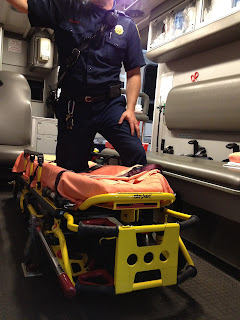Thursday evening I attended an incredibly exciting Citizen Fire Academy Class. The dozen class members sat through the classroom portion of the session, learning first about medical operations/EMT training from Lt. Michael Thomas (how the ambulances crews work). In the Gwinnett County Fire Department, all firefighters receive extensive EMT training, far more than what is required by the federal and state governments.
Then we were taught “Incident Command” (who’s in charge at a fire and why). Any one supervisor is in charge of no more than 5 to 7 people. That supervisor reports to the next one in the chain of command, who is responsible for no more than 5 to 7 supervisors. And so on up the line to the Fire Chief, to whom four departments report.
We learned how jobs are assigned at a fire. Divisions indicate a geographical area.
- Numbered Divisions are assigned vertically inside a building. For example, in an apartment fire, if your crew is assigned to Division 1, then your job would be to go into the first floor and do whatever needed to be done there, while Division 6 would take the 6th floor, and so on. On the outside of the building,
- Lettered Divisions are on the outside and they progress clockwise around the house. If you get to a fire and you’re assigned to Division A you know you’ll be responsible for the front of the house, while Division B will move to your left and cover that (left) side; C covers the back, and Division D is the right-hand side.
Groups, on the other hand, are assigned functions. If you’re assigned to the Ventilation Group, for instance, then your job is set the fans to blow the smoke out of the whole building (after the fire is out, of course). Likewise, a commander could assign you to Ventilation Group, Division 2, and you’ll know precisely what you’re supposed to do (ventilate) and where you’re supposed to do it (second floor).
After the classroom portion of the class, District Commander Chief Wayne Mooney led us all out into the station bay, where his vehicle sat. He opened the back and slid out an enormous tray that held more equipment than my kitchen contains. He walked us through the process he uses at a major fire of pulling magnets from the lid of one of the handy little boxes on the back of the tray and placing them in the appropriate rectangles marked on the sturdy built-in white-board chart, so he can see at a glance who is where at any given time.
 He has a different magnet for every unit (truck, ladder, car, ambulance…) that might be there, and every situation that might be going on (triage, helicopter, investigation...).
He has a different magnet for every unit (truck, ladder, car, ambulance…) that might be there, and every situation that might be going on (triage, helicopter, investigation...).White magnets indicate cars (CAR 1, CAR 2, CAR 3 and so on), Red ones were for the fire trucks (ENGINE 1, ENGINE 23, LADDER 5 . . .)
Other colors showed other types of situations, items, functions. And he even had a marker in case he ran out of magnets
The white board was divided into blocks where he could put magnets to show
1. where it was
2. who was there
3. what they were doing
As he explained all this, the ambulance and ladder truck, which had both been out on a call, returned. We all had to step aside so they could pull in through the doors at the back of the station and past us up to the front so they’d be ready to take off at a moment’s notice.
Lt. Thomas then jumped into the back of the ambulance and began to show us the equipment.
I was perched on the step at the back of the vehicle when an alarm sounded. We were shooed out of the way, firefighters jumped into the ladder truck and ambulance, and they were gone. Just like that.
There couldn't have been more than twenty seconds between the sounding of the alarm and this picture of the ambulance lights on and the truck beginning to move.
You may notice in the second picture that the ambulance driver brakes and waits for the fire truck to pull out in front. At a fire, the truck is more immediately necessary (usually) than the ambulance. The medic part of it comes later.
We class members were all shooting pictures like crazy through the whole process. I wish I could share them all with you, but I don’t want to jam your computer. I would like to leave you with the photo below, though. After the ladder truck was out of sight, I noticed four pairs of shoes on the floor of the bay, where the four men assigned to the ladder truck had jumped out of them and into their gear.
Let’s hear it for the firefighters.
BEEattitude for Day #528:
Blessed are those who put out clean water for the birds and who float a stick in there so we bees can climb out.
_______________________________
The teeny details:
my books: http://www.franstewart.com Please buy them from an independent bookstore or directly from my website.
my eBooks for Kindle: http://www.amazon.com/s/ref=nb_sb_noss?url=search-alias%3Ddigital-text&field-keywords=Fran+Stewart





2 comments:
My best friend here at the office was a volunteer fire fighter and my uncle in Del Rio, Texas, was a fire chief, as well as cousins who were/are fire fighters. What a great chance you're having to see how it's done 'up close & personal'. Love the story & photos!
I'll be sharing Firefighter stories each Friday for the next ten weeks.
So far I've been so impressed with what I've seen. Next week we'll be at the 911 center.
Post a Comment